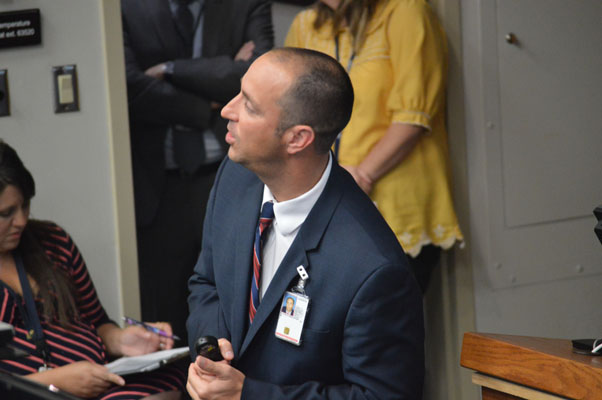story and photo by Traci Chapman
Oklahoma Department of Veterans Affairs administrators say a lot has improved in the VA’s reboot, but there is a long way to go – for patients and employees alike.
“We are very much on a learning curve, working to make the VA experience the best we possibly can for our veterans and their families, while we make sure our employees are happy and fulfilled, because that’s the way to make sure they are dedicated to giving the best care possible to our patients,” Oklahoma City VA Medical Center Director Wade Vlosich said.
The director’s comments were made during a Sept. 21 Town Hall, attended by dozens of veterans and staff members. Aimed at addressing both patient and staff concerns, the meeting was part of an effort to help move beyond years of bad press involving long wait times for care, employee concerns about hospital leadership and more at VA centers across the country. And, while the Town Hall gave individuals a chance to air ongoing issues, it was also a sign of a change in philosophy at the center, staff said.
“We are all working to make sure we are an active part of what we’re calling the ‘New VA,’” said Darrell Long, hospital specialty clinic float nurse. “We all know there is a bad perception out there, and we’re working to change that.”
Vlosich is a big part of that change, staff said. Joining the Oklahoma City VA facility in May, Vlosich is the first “permanent” director named in more than four years. With staff having no stable leadership to look to or lean on, Vlosich said it was difficult to provide both the kind of atmosphere needed for happy and quality employees, as well as the best in patient care.
“You just can’t make it work without stable and dedicated long-term leadership,” Vlosich said. “The quality of care we do offer is a testament to our employees – but now we owe them more too.”
That staff cares for more than 61,000 veterans annually, this year that number jumping by more than 3,000 over the number of patients seen two years ago, Vlosich said. The center’s $460 million budget funds a 192-bed hospital and emergency room operations, as well as a myriad variety of specialty clinics, including extensive mental health facilities. The VA also administers community centered outpatient clinics in north Oklahoma City, Lawton, Ada, Wichita Falls, Blackwell, Ardmore, Altus, Enid and Stillwater.
Employees have worked hard to address issues with wait times in all areas of the facility, something that’s been a longtime problem, Vlosich said. But, while the director has his work cut out for him in his new position, the challenge isn’t anything new. Before coming to Oklahoma City, he served as director of Harry S. Truman Memorial Veterans’ Hospital in Columbia, Missouri, for more than two years – a facility that before his arrival had been under “significant” fire for serious patient care issues.
“It was certainly a challenge, but we made some real improvement, and I know we will do the same – and better – here,” Vlosich said.
Like the Missouri facility, Vlosich said Oklahoma City has a major asset, its employees, and they are the primary key in hastening the forward strides needed to improve service.
“We are very lucky to have people with amazing dedication and talent, people like our specialty clinic chief, Terri Sharp,” the director said. “She and her staff have elevated our nursing services and make a huge difference in the lives of their patients.”
Those efforts have made a difference, with primary care waits dropping from seven days to three days, mental health from three days to two days and specialty care decreasing from 12 days to 11 days, Vlosich said.
“Obviously, that’s an improvement, but we have lots of room for more advancement,” he said.
Another frustration has been aged facilities, including inadequate parking for both staff and patients. Crews are working on a first and second floor clinic expansion, which will add 8,000 square feet and renovate another 16,000 square feet. A major parking addition should add 300 spaces and ease a situation that causes headaches on a daily basis, Vlosich said. The clinic project is slated for completion March 2017, while the new parking spaces should be ready by May 2017.
“We are also working to improve our facilities, which are a direct patient benefit but also is positive for our staff,” Vlosich said. “That allows us to keep the excellent employees we have happy, while allowing us to appeal to quality staff because, of course, we are only as good as the quality of our nursing/medical and other staff.”
That is an area that has seen forward momentum, staff said.
“There is a lot of excitement, a lot of commitment to the VA family,” said Leann Denney, a chemotherapy nurse navigator. “We have the greatest patients, and we are so committed to them because there is that additional component that they have served, they’ve sacrificed for all of us.
“That’s always been there, but there is also a new feeling that we are more of a coordinated team, that we will be able to better work together for the good of our patients,” she said. “We are a family here, all of us – nurses and staff, patients and their families – and we’re looking for things to just get better and better.”














